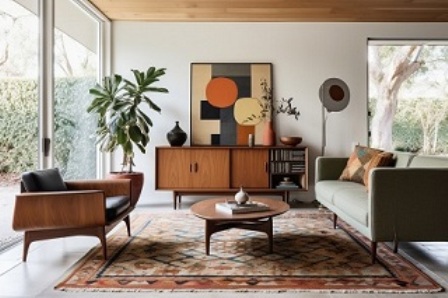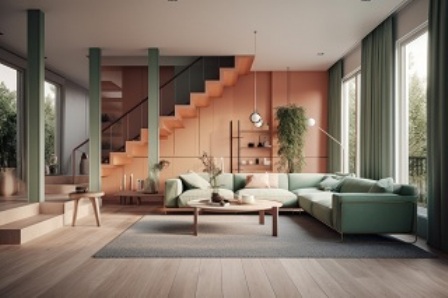
In the ever-evolving world of interior design, the quest to create spaces that both transcend fleeting trends and remain functionally up to date is challenging. For many designers and homeowners alike, achieving a harmonious blend of classic and contemporary elements is the ultimate design nirvana. This approach ensures longevity in terms of aesthetic appeal and creates interiors that resonate with a broad spectrum of personal tastes.
Historically, classic design has been characterized by its rich textures, intricate detailing, and meticulous craftsmanship – qualities that anchor spaces in a sense of tradition and history. However, the modern, contemporary design is lauded for its clean lines, minimalist ethos, and a strong inclination towards functionality. These two might seem like polar opposites, but the magic unfolds when they’re meticulously merged, yielding spaces that exude warmth, sophistication, and modernity.
Whether you’re seasoned interior designers, custom home builders, or homeowners searching for inspiration, the insights gathered in this article provide a fresh perspective on crafting interiors that truly stand the test of time.

Feature Original Pieces Like Ornate Moldings
Historically, ornate moldings graced the ceilings, doorways, and walls of grand mansions, palaces, and estates. They were status symbols, often hand-carved with utmost precision and attention to detail. Today, while such moldings have become more levelled, they retain their ability to elevate a space instantly. Their presence is a nod to a time when the subtleties of design were celebrated, allowing for a space to feel both luxurious and grounded in history.
Integrating these classic pieces into contemporary settings can be an exercise in balance. When done right, moldings can bridge the old and the new. Imagine a room with sleek modern furniture, monochromatic color palettes, and expansive glass windows. Now, introduce detailed crown moldings to this setting. The space transforms, with the moldings acting as a frame, drawing attention and adding depth, while the modern elements provide a clean backdrop that accentuates their beauty.
Use Soft And Tonal Neutrals On Walls
Soft neutrals, such as beige, taupe, or soft gray, have an inherent versatility. When set with classic features like ornate moldings or antique furnishings, neutral walls allow these elements to shine without competing for attention. Conversely, neutrals offer a seamless backdrop in a contemporary setting with modern art pieces or sleek furnishings, emphasizing the room’s present-day design elements.
The magic of tonal neutrals lies in their ability to adapt and evolve. Depending on the lighting, accompanying decor, or even the time of day, these hues can shift in character. A soft beige might appear warm and inviting during the day under natural sunlight but take on a deeper, cozier ambiance under the glow of evening lamps. This chameleon-like quality ensures the room remains dynamic and responsive to its surroundings.
But how does one go about selecting the perfect neutral? The trick is to consider the undertones. No matter how muted, every neutral carries an undertone—be it pink, yellow, blue, or green. Recognizing this undertone and ensuring it complements other elements in the room, both classic and modern, is crucial. For instance, a room with rich wooden furniture might benefit from a neutral with warm undertones, while a space with chrome fixtures and glass might resonate with a cooler neutral.
Pair Things Down By Keeping It Minimal
At the heart of creating timeless interiors lies a principle that has echoed through design periods: less is often more. While the grandeur of classic design elements like ornate moldings or intricate patterns holds an undeniable allure, the essence of modernity thrives on minimalism. By paring things down and embracing a minimalist approach, designers and homeowners can find a harmonious middle ground that allows both design philosophies to shine in concert.
Minimalism, in its most accurate form, isn’t about stark white spaces or a lack of decor. Instead, it champions intentionality, urging one to create purposeful spaces and select each piece with thought. This philosophy can be a saving grace when integrating classic and contemporary elements. By reducing clutter and focusing on key pieces, whether a vintage chaise lounge or a sleek modern coffee table, each item in the room is given space to breathe, be noticed, and be appreciated.
Avoid Fads And Passing Trends
From the color of the year to the latest in furniture design, the design industry, like fashion, is constantly in flux. While these fleeting trends can offer freshness and novelty, the quest for timeless interiors requires a discerning eye to differentiate between what’s momentarily in vogue and what possesses enduring charm. To truly merge the best of classic and contemporary design elements, one must tread carefully, sidestepping the call of fads.
However, this isn’t to say one should shun all contemporary trends. The essence of merging classic and modern requires a pulse on the present, with the trick lying in discernment. It’s about adopting elements that align with broader, long-lasting design philosophies and will likely retain their appeal over time.
Incorporating timeless pieces—whether a mid-century modern sofa, a classic wingback chair, or the sleek lines of contemporary Scandinavian design—ensures the space remains adaptable to minor updates in the future. It allows homeowners and designers the flexibility to introduce or swap more minor elements, providing a fresh feel without a complete overhaul whenever they desire change.
Choose Elegant And Bespoke Furniture Choices
Beyond functional entities, furniture pieces act as anchors, setting the room’s tone and character. For interiors aspiring to timelessness, the mantra is clear: lean towards elegant, bespoke furniture choices that seamlessly blend tradition with innovation.
Elegance in furniture is often epitomized by clean lines, impeccable craftsmanship, and a particular understated luxury. Whether it’s a tufted Victorian-era settee or a sleek, modern-day minimalist couch, the common thread lies in their ability to command attention without shouting for it. Regardless of their design era, elegant furniture pieces share a certain universality in appeal, ensuring they remain relevant and adored across shifting design landscapes.
Bespoke, or custom-made furniture, further elevates this narrative. Opting for bespoke pieces ensures every item is tailored to the room’s specific aesthetic and functional needs. This level of customization guarantees uniqueness and ensures that the furniture complements other design elements in the room.
Final Thoughts
The beauty of interior design lies not in strict adherence to a single style or era but in the artful blending of diverse influences. By interweaving elements from different periods, designers and homeowners alike can create spaces rich in narrative, enveloping occupants in a tapestry of ancient and modern stories. These spaces serve as a testament to the timeless nature of good design, proving that with careful thought and curation, interiors can defy temporal bounds and resonate deeply across generations. With the sources of inspiration above, now you too, can make your dream of a classic and contemporary home come to life.